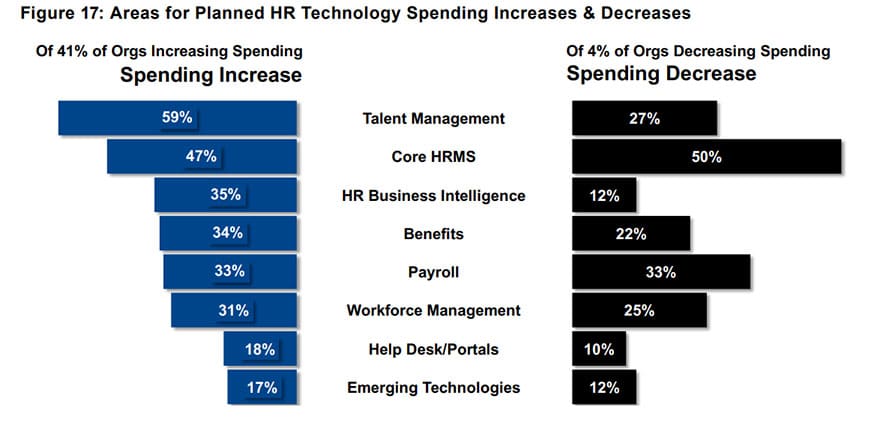Long-held preconceptions about the human resources department are changing. The team is increasingly being recognized for its important role in creating strategic value to the business—and so is technology like HR software.
For more than 20 years, consultancy Sierra-Cedar has deployed an HR Systems Survey that measures technology adoption by human resources professionals. The 2020 report includes insights from 1,892 companies with more than 22 million workers. One top finding: A 20% increase in the number of respondents who view HR as contributing strategic value, with business executives 25% more likely to view HR as strategic even compared with those within the department itself.
There is a connection between that view and the broader use of HR software, with the survey saying that “elevating the perception of HR and investing in specific approaches to HR technology strategy, integration and change management correlate to 15% year-over-year increases in overall outcomes.”
Why HR Software?
The principles of human capital management dictate that most people within an organization will interact with HR software at some point during their careers. It is used by employees to manage the many important matters that aren’t directly related to their jobs but are part of the employee experience, including time off, benefits, payroll and more. It is leveraged by human resources professionals and leaders in the department to streamline the process of collecting and maintaining accurate employee-related data and making sure the business is in compliance with federal and state health, safety and labor laws.
Managers use HR software to help employees develop new skills and progress in their careers and to track their performance, as well as scheduling employees for work and making note of any workplace issues. Finance teams appreciate reports on tax compliance, payroll and benefits expenditures and headcount analysis to project future costs.
And in leading organizations, lots of people across the business use data from HR systems to improve the employee experience.
HR software includes:
- HRMS or HRIS functionality helps HR manage personnel information; payroll; and benefits administration and HR service delivery functions, such as HR help desk and employee self-service.
- Workforce management functions include time clocks, time off and absence management and scheduling.
- Talent management functions, such as recruiting, onboarding, career planning, performance, learning and development, compensation and succession planning, help HR teams stay on top of what skills the company needs.
Leading software also includes:
- Workforce BI and analytics, IoT applications and artificial intelligence.
Benefits of HR software
Much like the department itself, the value propositions of human resources applications are changing. Administrative tools to ease data collection and enable employee self-service are becoming table stakes—and leading organizations are leveraging HR software to optimize and more deeply engage the workforce.
In fact, the Sierra-Cedar report finds that HR applications are central to an organization’s ability to manage workforce productivity and culture while also governing the use of sensitive workforce data.
The benefits include:
- Efficiency and productivity: Sierra-Cedar research shows that almost 80% of organizations are using HR software to facilitate information gathering or add process efficiencies. There’s no doubt that companies with sophisticated HRMS systems reap significant gains in talent retention while freeing up HR staff for value-added projects and minimizing audit findings.
- Employee experience/morale: Many HR pros saw the headlines. A much-publicized Gallup poll pegged the percentage of engaged workers during 2020 at just 36%, on average. The largest decline in employee engagement was among those in managerial or leadership positions, and, among other trends, was more pronounced for those working onsite vs. at home. The tools found in HR software play a role in enhancing the employee experience. Some examples include measuring sentiment regularly with pulse surveys, connecting people with apps that allow for peer recognition and offering discounts on benefits through gamification.
- Employee development/retention: The biggest HR software investment for organizations surveyed by Sierra-Cedar is in talent management tools; the top functionalities sought are around recruiting, onboarding and performance management. That’s not surprising given that organizations spend a lot of time and money getting people to work for them: The Society for Human Resources Management (SHRM) found that, on average, new hires cost a business $4,219, and it takes 42 days on average to fill an open position. Getting good people on board is important but keeping them is even more so—the experience and morale functionality mentioned above play into retention efforts.
- Cost savings: Managing payroll and benefits costs is a top priority for all organizations, given that salaries, payroll taxes and benefits are generally among the largest line items. HR management systems provide human resources teams with a number of ways to save, without cutting back on the employee experience. Take the rising cost of health insurance. By better tracking data around benefits, a company has more leverage to negotiate rates with carriers. What’s more, gamification functionality encourages and makes it easy for employees to develop healthy lifestyle habits to access rewards and discounts on premiums—all of which benefit the employer.
- Reduced errors: Automating payroll is a high-value area for small businesses because manual data entry results in the most payroll errors. Besides the time required to correct mistakes, errors in tax withholding open the company up to IRS penalties.
- Regulatory compliance: Making sure the business is complying with regulations at the state and federal level has long been the responsibility of human resources—and that job is only expanding in scope. HR must now account for HR compliance violations borne of everything from cybersecurity breaches to entirely new work models and changes to labor laws brought on as a result of the pandemic. Organizations report a high rate of success in using their HR systems to monitor compliance needs, with 69% of HR organizations in the Sierra-Cedar survey saying that they are effectively using their HR systems to monitor and report on compliance.
- Attendance monitoring: Timecard fraud happens, and it costs organizations time and money. Fraud can run the gamut from taking long lunch breaks, to “buddy punching,” when a friend clocks in for an employee running late, to billing for hours that weren’t actually worked. Time clock systems require employees to swipe their employee IDs to punch in, which eliminates some of those issues. They add another layer of security by requiring manager approval and can also be configured to send alerts to managers if timelines aren’t adding up.
- Simplified benefits administration: The process of designing and managing employee benefits is complex, even for small companies. In fact, the cost of health insurance surfaces as the biggest issue for small firms in study after study, including the very small businesses surveyed by health care researcher The Commonwealth Fund. Among 500 small-business owners who provide health coverage to their employees, the cost of providing health care coverage to employees was cited as the No. 1 challenge, ahead of attracting new customers and other issues. Keeping up with changing government rules and regulations and the time required for administration and paperwork are also challenging. Benefits administration functionality in HR software automates calculations of benefits eligibility, allows self-service by employees to pick coverage and integrates with payroll to make sure the correct amount is deducted from the employee’s paycheck. This is more accurate and saves time.
- Data security: HR, working with the internal communications team, must ensure that relevant security policies are kept up-to-date and that employees know how to identify and what to do with, for instance, phishing emails that contain malicious attachments or links. HR software processes keep policies current and ensure employees have signed off. On the HR side, the system provides role-based access and rules in the system that guard against unauthorized access to employee data in the first place. Among the most common, and expensive, causes of breaches: Stolen or compromised employee accounts and credentials, according to IBM’s 2020 Cost of a Data Breach survey.
- Metrics: Access to metrics for analysis is critical for HR cost management, compliance risk management and improved employee engagement. The top source of that information is the HR system. In fact, Oracle research shows that HR may be overtaking finance as an analytics-driven function. HR teams are using data to determine future workforce plans and predicting turnover in critical roles. Easy access to data that is both accurate and that can be viewed in real-time helps the business connect metrics to business goals. For instance, organizations trying to rein in recruiting costs can easily track crucial metrics, such as time to hire and cost per hire, alongside voluntary and involuntary turnovers. This helps tie costs to quality of hire.
- Improved decision-making: When HR professionals aren’t spending lots of time on administrative tasks and can trust that day-to-day benefits, payroll and personnel administration are accurate, they can focus on improving the overall employee experience. If the benefits administrator isn’t mired in trying to ensure compliance and providing reporting, she can look for new ways to educate and engage the workforce on the benefits available to them—thereby raising morale and aiding in retention.
Simplify
HR and Payroll
Choosing the Right HR software
It’s an interesting time for HR software providers. Forrester Research found that only 41% of global software decision makers say they’re satisfied with existing HCM products and plan to keep their systems. Some 56% are looking at alternate products, from either their existing vendors or new providers. Sierra-Cedar’s research says smaller companies are looking to increase spending in benefits administration, while larger organizations are looking to adopt analytics and advanced technologies such as artificial intelligence.
Competitive HCM platforms offer HRMS functionality such as benefits administration, simplified compliance and related reporting and the ability to analyze employee data in a way that fits the needs of the business. It also factors in trends in employee engagement, such as increasing collaboration, and enabling employees to recognize the contributions of their coworkers through more social tools.
More than 70% of companies surveyed in Sierra Cedar’s research had deployed at least one cloud-based HR application, and the firm found that new buyers expect a software-as-a-service/cloud option: “In fact, moving to a cloud environment is generally not a question of if, but when.”










